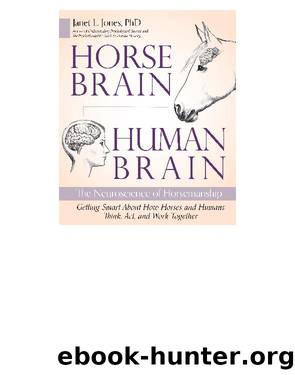Horse Brain Human Brain by Unknown

Author:Unknown
Language: eng
Format: epub
Published: 2020-07-14T10:02:10+00:00
Add to this list any extra items your particular horse enjoys. Then rank them based on your horse’s desires and on your ability to deliver the reward at the right time. For example, most equines find withers scratching and neck stroking much more pleasant than patting. Stroking a horse’s neck reduces his heart rate—and yours. It’s easy to deliver, too—it can be done within a second or two of good behavior using the back of your knuckles while holding both reins. This is a distinct advantage when you need to reward at a gallop and prefer to avoid a face plant.
Verbal praise is also effective while mounted because you don’t have to change your body position to provide it. Pair it first with known rewards, so the horse learns that “good job” is a form of praise. After that, the words alone will do the trick. Just avoid the common error of associating verbal praise with slower motion—you don’t want your harness trotter to put on the brakes every time he hears an, “Attaboy!”
Non-edible rewards allow you to pamper your horse, offer pleasure or appreciation, and aid learning. Better yet, they do not come with the problems that treats create. Often, we give animals goodies only to make ourselves feel better. But there are a million ways to show a horse your love. Spend five minutes scratching the “love spot” on his crest a few inches in front of his withers. He’ll show you where it is! Offer calm reassurance in the face of fear; that’s better than food. Tend gently to his wounds when he’s injured; take him for an easy walk or a visit with his horse friends; massage his muscles for a while. Food sparks a horse’s momentary attention, but non-edible rewards build longstanding bonds of trust (fig. 12.2).
Timing
Mammals associate a reward with whatever happened immediately preceding it. We have high expectations for equine behavior, and horses are usually alert and active when working in their horse-and-human team. This means they are likely to produce a series of behaviors in rapid succession. For these reasons, we have to reward within two or three seconds of a desirable behavior, before the horse does something we don’t want to reinforce. If you’re slow to notice a desired behavior, it’s too late. The spark has missed the piston.
Download
This site does not store any files on its server. We only index and link to content provided by other sites. Please contact the content providers to delete copyright contents if any and email us, we'll remove relevant links or contents immediately.
| Administration & Medicine Economics | Allied Health Professions |
| Basic Sciences | Dentistry |
| History | Medical Informatics |
| Medicine | Nursing |
| Pharmacology | Psychology |
| Research | Veterinary Medicine |
Periodization Training for Sports by Tudor Bompa(7946)
Why We Sleep: Unlocking the Power of Sleep and Dreams by Matthew Walker(6388)
Paper Towns by Green John(4826)
The Immortal Life of Henrietta Lacks by Rebecca Skloot(4274)
The Sports Rules Book by Human Kinetics(4097)
Dynamic Alignment Through Imagery by Eric Franklin(3935)
ACSM's Complete Guide to Fitness & Health by ACSM(3834)
Kaplan MCAT Organic Chemistry Review: Created for MCAT 2015 (Kaplan Test Prep) by Kaplan(3815)
Introduction to Kinesiology by Shirl J. Hoffman(3634)
Livewired by David Eagleman(3547)
The River of Consciousness by Oliver Sacks(3431)
The Death of the Heart by Elizabeth Bowen(3355)
Alchemy and Alchemists by C. J. S. Thompson(3312)
Descartes' Error by Antonio Damasio(3170)
Bad Pharma by Ben Goldacre(3118)
The Gene: An Intimate History by Siddhartha Mukherjee(2942)
The Emperor of All Maladies: A Biography of Cancer by Siddhartha Mukherjee(2942)
The Fate of Rome: Climate, Disease, and the End of an Empire (The Princeton History of the Ancient World) by Kyle Harper(2893)
Kaplan MCAT Behavioral Sciences Review: Created for MCAT 2015 (Kaplan Test Prep) by Kaplan(2832)
